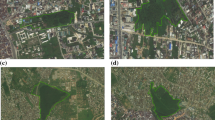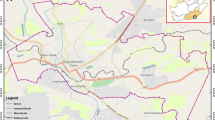Abstract
A combined approach of remote sensing (RS) and geographical information systems (GIS) was used in this study to identify the impact on urban surface radiant temperature (SRT) of urban green-space change. Urban SRT increases as green-space area is converted into non-green-space area. Also, well preserved green space and newly connected green space contribute to a decrease of the SRT. Seoul Metropolitan area is rapidly expanding. Existing urban SRT studies have, however, mainly been conducted for Seoul City. The most rapidly expanding area in Korea is now the Seoul suburban area, for example the Mt Gwanggyo area. Although changes of SRT and normalized difference vegetation index (NDVI) as a result of land-use change have been measured in many other studies, the results in these studies were derived from data from different seasons. Also, these studies did not examine a newly expanding area. Considering these problems, the same seasonal multitemporal data were used in this study to derive the SRT change for the same season in different years. This study confirmed the importance of effective management and location of urban green space for urban SRT mitigation. Ultimately, the impact on urban SRT of urban green-space change should be regarded as an important factor in urban planning.



Similar content being viewed by others
References
Chander G, Markham B (2003) Revised Landsat-5 TM radiometric calibration procedures and postcalibration dynamic ranges. IEEE T Geosci Remote 41:2674–2677
Cho Y-H, Shin S-Y (2002) The effects of urban forest on summer air temperature in Seoul, Korea. J Korea Soc Landscape Architecture 30(4):28–36
Department for transport, local government and the regions (DTLR) (2002) Green spaces, better places—final report of the urban green spaces taskforce. Eland House, Bressenden Place, London
Design Center for American Urban Landscape (DCAUL) (2003) Urban green space: effects on water and climate, 1. Rapson Hall, Minneapolis, MN
Gallo KP, Owen TW (2002) A sampling strategy for satellite sensor-based assessments of the urban Heat-Island bias. Int J Remote Sens 23:1935–1939
Goetz SJ (1997) Multi-sensor analysis of NDVI, surface temperature and biophysical variables at a mixed grassland site. Int J Remote Sens 18:71–94
Jo M-H, Lee KJ, Kim W-S (2001a) A study on the spatial distribution characteristic of urban surface temperature using remotely sensed data and GIS. J Korean Assoc Geographic Info Stud 4(1):57–66
Jo M-H, Kwon B-K, Jo Y-W (2001b) The spatial topographic analysis of urban surface temperature using remote sensed data and GIS. 22nd Asian Conference on Remote Sensing, 5–9 November 2001, Singapore
Kant Y, Badarinath KVS (2000) Studies on land surface temperature over heterogeneous areas using AVHRR data. Int J Remote Sens 20:1749–1756
Korea Institute of Geoscience and Mineral Resources (1972) Suwon. Geological atlas of Korea, Daejeon City
Korea Institute of Geoscience and Mineral Resources (1975) Anyang. Geological atlas of Korea, Daejeon City
Korea Institute of Geoscience and Mineral Resources (1982) Doonjeon. Geological atlas of Korea, Daejeon City
Lagouarde JP, Moreau P, Irvine M, Bonnefond JM, Voogt JA, Solliec F (2004) Airborne experimental measurements of the angular variations in surface temperature over urban areas: case study of Marseille (France). Remote Sens Environ 93:443–462
Landsat Project Science Office (2002) Landsat 7 science data users handbook. http://www.gsfc.nasa.gov/ISA/handbook/handbook_toc.html. Goddard Space Flight Center, NASA, Washington, DC
Lillesand T, Kiefer R (1999) Remote sensing and image interpretation, 4th edn. Wiley, New York, p 330 (see also pp373–451)
Lo CP, Quattrochi DA, Luvall JC (1997) Application of high-resolution thermal infrared remote sensing and GIS to assess the Urban Heat Island Effect. Int J Remote Sens 18:287–304
Miller RW (1997) Urban forestry: planning and managing urban greenspaces, 2nd edn. Prentice Hall, Upper Saddle River, pp 45–79
Munier K, Burger H (2001) Analysis of lands use data and surface temperatures derived from satellite data for the area of Berlin. Conference on Remote Sensing in Urban Environments, Regensburg. http://userpage.fu-berlin.de/~hburger/hb/munburg.pdf
Park M-H (2001) A study on the urban heat island phenomenon using Landsat TM thermal infrared data—in the case of Seoul. J Korean Soc Civil Eng 21(6D):861–874
Qin Z, Karnieli A, Berliner P (2001) A mono-window algorithm for retrieving land surface temperature from Landsat TM data and its application to the Israel–Egypt border region. Int J Remote Sens 22:3719–3746
Roy DP (1997) Investigation of the maximum normalized difference vegetation index (NDVI) and the maximum surface temperature (TS) AVHRR compositing procedures for the extraction of NDVI and TS over forest. Int J Remote Sens 18:2383–2401
Sohn JM (1998) The story of urban plan in Seoul—introduction of Gangnam development plan (I). Mon Publ Kook-Toh 205:87–99
Southworth J (2004) An assessment of Landsat TM band 6 thermal data for analysing land cover in tropical dry forest regions. Int J Remote Sens 25:689–706
Taylor J, Paine C, FitzGibbon J (1995) From Greenbelt to Greenways: four Canadian case studies. Landscape Urban Plan 33:47–64
Voogt JA, Oke TR (1997) Complete urban surface temperature. J Appl Meteorol 36:1117–1132
Weng Q (2001) A remote sensing-GIS evaluation of urban expansion and its impact on surface temperature in the Zhujiang Delta, China. Int J Remote Sens 22:1999–2014
Weng Q (2003) Fractal analysis of satellite-detected Urban Heat Island Effect. Photogramm Eng Rem S 69:555–566
Weng Q, Lu D, Schubring J (2004) Estimation of land surface temperature-vegetation abundance relationship for Urban Heat Island Studies. Remote Sens Environ 89:467–483
Yang JS, Wang YQ (2002) Estimation of land surface temperature using Landsat-7 ETM+ thermal infrared and weather station data. Proceedings of Huangshan International Thermal Infrared Remote Sensing Workshop, July 14–17, Huangshan, Anhui
Author information
Authors and Affiliations
Corresponding author
Rights and permissions
About this article
Cite this article
Shin, Dh., Lee, Ks. Use of remote sensing and geographical information systems to estimate green space surface-temperature change as a result of urban expansion. Landscape Ecol Eng 1, 169–176 (2005). https://doi.org/10.1007/s11355-005-0021-1
Received:
Revised:
Accepted:
Published:
Issue Date:
DOI: https://doi.org/10.1007/s11355-005-0021-1




